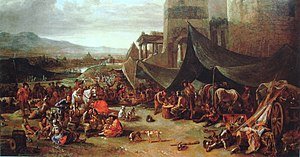1527: Sack of Rome
On May 6th, 1527, a significant event unfolded in the city of Rome. Spanish and German troops, under the leadership of Charles III, Duke of Bourbon, launched a brutal attack on the city. This event, known as the “Sack of Rome,” marked the end of the Renaissance era in the city and had far-reaching consequences for its cultural influence.
The Italian Wars
The Sack of Rome occurred during the Italian Wars, a series of conflicts that involved various European powers vying for control over the Italian peninsula. The wars were characterized by shifting alliances and frequent military campaigns, with Rome often finding itself at the center of these conflicts.
In 1527, Rome was under the rule of Pope Clement VII, who had aligned himself with the French against the Holy Roman Emperor, Charles V. This political situation set the stage for the events that would unfold on that fateful day in May.
The Attack
The forces that attacked Rome were primarily composed of mutinous soldiers, who were seeking unpaid wages and loot. Charles III, Duke of Bourbon, led the troops, which were a mixture of Spanish and German soldiers. The attack was swift and merciless, catching the inhabitants of Rome off guard.
The attackers quickly overwhelmed the city’s defenses and embarked on a rampage of destruction and pillaging. Thousands of people were killed, and countless buildings, including churches, palaces, and libraries, were looted and set ablaze. The attackers showed no mercy, sparing neither the clergy nor the civilian population.
The Cultural Impact
The Sack of Rome had a profound impact on the city’s cultural landscape. Countless works of art, manuscripts, and ancient artifacts were destroyed or stolen during the attack. Priceless masterpieces by renowned artists such as Raphael and Michelangelo were lost forever.
The event effectively crippled Rome’s cultural influence, as many artists and scholars fled the city in the aftermath of the attack. The Renaissance, which had flourished in Rome for decades, came to an abrupt end. The loss of artistic and intellectual talent had long-lasting consequences for the city’s reputation as a center of culture and learning.
Legacy and Historical Significance
The Sack of Rome was a turning point in European history. It marked the decline of the Renaissance and the beginning of a new era characterized by political and religious turmoil. The event also highlighted the vulnerability of even the most powerful and influential cities.
Furthermore, the Sack of Rome had a profound impact on the relationship between the Church and the state. The attack on the spiritual center of Catholicism shocked the Christian world and contributed to the ongoing religious conflicts of the time.
References:
- Sack of Rome (1527) – Britannica
- Sack of Rome – History.com
- The Sack of Rome (1527) – The Metropolitan Museum of Art
In conclusion, the Sack of Rome in 1527 was a devastating event that marked the end of the Renaissance era in the city. The attack led by Charles III, Duke of Bourbon, resulted in the loss of countless lives and the destruction of priceless art and architecture. The cultural impact of this event was significant, as Rome’s influence as a center of culture and learning was severely diminished. The Sack of Rome stands as a reminder of the vulnerability of even the most powerful cities and has left a lasting legacy in European history.

